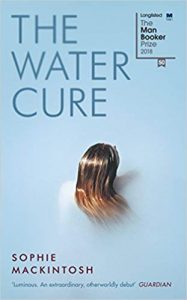 Three sisters, Grace, Lia and Sky live in a large house that used to be a retreat for suffering women seeking to heal themselves from the wrongs of men. The sisters live there with their father and mother. They undergo treatments and cures, they prepare themselves for the fight against the contaminated world outside the parameters of the house. They survive on goods their father brings from the mainland. He sails away for three days, trading talismans that the women sew, wearing a white suit to deflect contamination.
Three sisters, Grace, Lia and Sky live in a large house that used to be a retreat for suffering women seeking to heal themselves from the wrongs of men. The sisters live there with their father and mother. They undergo treatments and cures, they prepare themselves for the fight against the contaminated world outside the parameters of the house. They survive on goods their father brings from the mainland. He sails away for three days, trading talismans that the women sew, wearing a white suit to deflect contamination.
The rituals and treatments, the cures, are cruel, designed to test obedience and strength, to keep their womanly and dangerous feelings in check.
Then their father is gone with one of the boats. A blood stained shoe washes up on the shore. What will they do now he is gone?
There is much to admire in this novel. The constant uncertainty about the world these girls live in – is it really contaminated outside their borders? Are men really such a threat? Have things changed? – and the way their family has been forced to look inwards makes for a claustrophobic and intense narrative in which their relationships with each other count more than anything. That intensity is compelling and unnerving, born out in chapters that are sometimes from one daughter’s perspective and sometimes from all three. The passion they feel for each other is not only loving it is also jealous, full of fear and ripe with violence.
I thoroughly enjoyed reading this novel. I can’t say what it is that I take away though. I’m not sure what it means to say or question about the inherent tendencies of men and women – a subject it definitely explores. I can’t predict what the girls will find at the end of the novel either. In a sense, it’s a book made for a Netflix adaptation with this book as the first series, ending on a cliffhanger that could go in multiple directions. I know that the relationships between the sisters are compelling enough to make me want to see more of them, to uncover more details of their past and to see how their personalities and loves would be revealed or shaped by what they go on to find, but I’m left with very little sense of the world they will encounter or how necessary their outlook will prove to be. It’s an end that promises a new beginning – which is great – but also leaves little sense of resolution.
You could argue that the novel is a meditation on family, on those strange rules and rituals that we all take for granted in our nuclear groupings. The rules we don’t fully question until we experience the lives of other families, or until we grow enough to see our parents manipulate the rules they set out, forcing questions about the motivations and origins of the rules. Even then changing rules is difficult. They are sometimes impossible to completely destroy as if a certain way of being and reacting has become part of our flesh, painful to evict, hard to avoid.
One of the rituals that seems to be motivated by fairness, is the ritual of drawing irons. It’s a confusing ritual, the particulars of which don’t make a lot of sense, but the general idea is that once a year each person draws an iron and the name on the iron becomes the person they are paired with most intently that year, the person they should love above others and save first should there be some disaster. There is also a blank iron and if you draw that no one has you as their particular love for that whole entire year. You are starved of affection. What is initially presented as a way of levelling out the natural desire to love one person differently to another becomes a way of measuring and apportioning love which becomes as unjust. Why not love more than one person with equal intensity but different expression? Rather than fairness, it brings about hierarchy and cruelty. And as one of the daughters notices, it is also a game that is easily rigged, using the ritual to cement a parent’s greater love for one child over another. All of the rituals have this eery duality, suggesting sense, practicality, necessity whilst delivering suffering and abuse. It feels as if the girls could have no hope of making sense of the world or of forging relationships with other people with these rules and rituals as their guides for love and life.
So the novel is certainly intriguing and though I didn’t entirely fall in love with The Water Cure, I would definitely be interested in reading another novel by Sophie Mackintosh.
Next week I’ll be reviewing Hazards of Time Travel by Joyce Carol Oates.